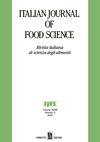利用农业分析评估硬质小麦陆地品系遗传多样性及其对人类健康的益处
IF 3.3
4区 农林科学
Q2 FOOD SCIENCE & TECHNOLOGY
引用次数: 0
摘要
古老的小麦和地方品种(传统品种)吸引着科学家们的目光,他们正在重新评估民间传统赋予它们的健康和饮食特性。小麦(硬质小麦)是全世界种植的最重要作物之一。在本研究中,通过形态学和 SDS-PAGE 分析对 19 个地方品种进行了遗传多样性分析。穗长的变异系数最高(18.91%),成熟天数的变异系数最低(1.51%)。基因型 Malakand 和 Dolram 产生的种子数量最多(每株 42 粒和 46 粒),基因型 Dogai 和 Rasool Banda 最高(分别为 73 厘米和 71 厘米)。基因型 Kamar Kotki 成熟较早(165 天),而 Doagi 成熟较晚(171 天)。穗长与株高、叶宽和叶长呈正相关。叶宽与穗长和节间距离显著相关。聚类分析将所有基因型分为 6 个子聚类,其中 Asban 和 Shekhan 位于树枝图的极端。根据种子贮藏蛋白总量分析,18 条(85.71%)条带具有多态性,14.28%的条带具有单态性。利用沃德方法,所有基因型按 25% 的欧氏距离分为两个主系,按 75% 的欧氏距离分为五个亚群。我们的研究结果对了解各种硬质小麦基因型之间的变异和关系具有重要意义,并可作为地方适应性硬质小麦精英种质的基础。本文章由计算机程序翻译,如有差异,请以英文原文为准。
Evaluation of the durum wheat landrace genetic diversity using agro analysis and its benefit for human health
Ancient wheat and landraces (traditional varieties) are fascinating to the consideration of scientists who are re-evaluating the healthy and dietary properties attributed to them by popular tradition. Wheat (Triticum durum) is one of the most significant crops that is grown all over the world. In the present study, 19 landraces were analyzed for genetic diversity through morphological and SDS-PAGE analysis. The highest coefficient of variance (18.91%) was found for spike length, and the lowest for days to maturity (1.51%). The genotype Malakand and Dolram produced a maximum number of seeds (42 and 46 seeds per plant), and the genotypes Dogai and Rasool Banda were found to be the tallest (73 and 71 cm, respectively). The genotype Kamar Kotki was found to mature early (165 days) while Doagi was found to mature late (171 days). Spike length was found to be positively correlated with plant height, leaf width, and leaf length. Leaf width was significant with spike length and the internode distance. The cluster analysis divided all the genotypes into six sub-clusters where the Asban and the Shekhan were placed at the extreme of the dendrogram. Based on the total seed storage proteins analysis, 18 (85.71%) bands were polymorphic while 14.28% bands were found to be monomorphic. Using Ward’s methods, all the genotypes were divided into two main lineages at 25% Euclidian distance and five sub-clusters at 75% distance. Our findings have significance for understanding the variations and relationships between various durum wheat genotypes and could serve as a basis for local elite durum germplasm that has been regionally adapted.
求助全文
通过发布文献求助,成功后即可免费获取论文全文。
去求助
来源期刊

Italian Journal of Food Science
工程技术-食品科技
CiteScore
4.20
自引率
0.00%
发文量
33
审稿时长
>36 weeks
期刊介绍:
"Italian Journal of Food Science" is an international journal publishing original, basic and applied papers, reviews, short communications, surveys and opinions on food science and technology with specific reference to the Mediterranean Region. Its expanded scope includes food production, food engineering, food management, food quality, shelf-life, consumer acceptance of foodstuffs, food safety and nutrition, energy and environmental aspects of food processing on the whole life cycle.
Reviews and surveys on specific topics relevant to the advance of the Mediterranean food industry are particularly welcome.
 求助内容:
求助内容: 应助结果提醒方式:
应助结果提醒方式:


